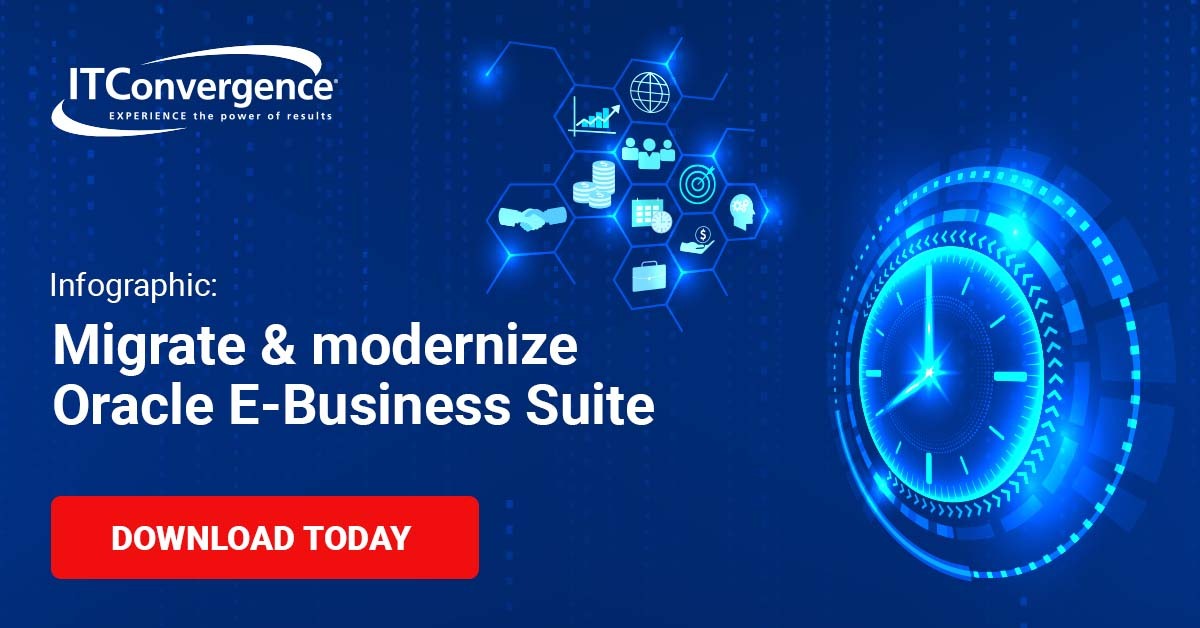For organizations leveraging Oracle ERP solutions, upgrading to the latest release, Oracle 12.2, presents a myriad of opportunities to enhance efficiency, streamline operations, and drive business growth. In this blog, we’ll delve into the compelling benefits that upgrading to Oracle 12.2 offers and why it’s a strategic move for businesses seeking innovation and agility.
Benefits of Upgrading to the latest Oracle Release
1. The Functional Improvements that R12.2 Offers are Essential
Oracle 12.2 introduces a host of new features and functionalities designed to empower organizations with greater flexibility, capabilities, enhanced operational efficiency, support for contemporary business models, and modernized user interfaces. From advanced analytics tools to improved reporting functionalities, upgrading to Oracle 12.2 enables businesses to unlock new possibilities and leverage cutting-edge technology to drive operational excellence. You can take advantage of these functional improvements, along with the Online Patching and the mobile application features added in R12.2. You may also be able to standardize your business processes and lower the expense and complexity of maintaining your customizations by substituting your customizations with the standard features included in the latest release of R12.2. Remember that Release 12.2 brings new compliance, code, and patching standards that customizations must follow.
2. You Wish to Lower the Costs of EBS Support and Maintenance
While the initial investment in upgrading to Oracle 12.2 may seem significant, the long-term cost savings and return on investment (ROI) can be substantial. By leveraging the latest technologies and streamlining processes, Oracle 12.2 helps organizations reduce operational costs, minimize downtime, and optimize resource utilization. Additionally, the scalability and flexibility of Oracle 12.2 ensure that businesses can adapt to changing business needs without incurring significant additional costs. By using open standards and upgrading to R12.2, you can lower the total cost of ownership support and maintenance costs for your EBS setup. Oracle no longer supports versions 11i and below, therefore customers using later operating systems and browser releases may encounter security concerns and certification issues. Oracle also no longer fixes any new issues that develop.
3. You Must Continue to Comply
Upgrading to R12.2 guarantees that you stay compliant with SOX (Sarbanes Oxley), ITAR (International Traffic in Arms), and other regulations, and that you receive the most recent tax and regulatory upgrades from Oracle.
4. You Wish to Combine Several Instances of EBS
Companies with several business units using various Oracle EBS versions or those that have just acquired businesses using older ERP systems like QAD, AS/400, etc. are examples of common cases. Upgrading to R12.2 will combine your business units into a single global instance, which will help simplify the complexity of the application.
5. You Need Enhanced Security
With cybersecurity threats on the rise, safeguarding sensitive data and protecting against potential breaches is paramount for organizations. Oracle 12.2 introduces robust security features and enhancements, including advanced encryption capabilities, enhanced access controls, and improved audit trails, providing organizations with peace of mind and ensuring compliance with regulatory requirements.
6. Enhanced User Experience
Oracle 12.2 offers a revamped user interface and intuitive design, making it easier for users to navigate the system, access relevant information, and perform tasks efficiently. With a user-friendly interface and enhanced usability features, upgrading to Oracle 12.2 can drive greater user satisfaction and productivity across the organization.
7. Latest Release Offers a Seamless Integration
Oracle 12.2 offers enhanced integration capabilities, enabling organizations to seamlessly integrate with third-party applications, cloud services, and other Oracle products. By upgrading to Oracle 12.2, businesses can streamline their IT ecosystem, improve data visibility, and drive collaboration across departments.
8. You are Prepared to Move to the Cloud but are Devoted to Oracle’s Guidance
Numerous new features and improvements to the User Interface are available to assist in modernizing your business procedures for increased operational effectiveness. Additionally, you may make use of the Online Patching feature, which lowers downtime for patching and maintenance while increasing availability.
How to be Ready for an Update to R12.2
- Functional Evaluation: You can decide which customizations to replace with R12.2 standard functions by doing a complete functional examination.
- Impact Assessment of Customisation: You can better understand the impact of the update and the complexity of your degree of customization by doing a pre-upgrade impact assessment. Organizing customizations according to object type (databases, setups, RICEFW/CEMLIs), as well as identifying which objects will need code modifications, are some examples of this effort. This exercise can assist you in comprehending the time and effort needed to fix the custom code as well as the kinds of resources (developers, techno-functional consultants, etc.) required for the upgrade.
- Automation Instruments: Examine the different technologies that are available to automate testing and code remediation, two repetitious upgrade processes.
At IT Convergence, our team of experienced consultants brings deep expertise in Oracle ERP solutions and a proven track record of successful upgrades. From initial planning and assessment to execution and post-implementation support, we work closely with our clients to ensure a smooth and efficient upgrade process. Leveraging best practices, industry standards, and innovative tools, we help organizations minimize disruption, mitigate risks, and maximize the benefits of upgrading to the latest release. With our comprehensive approach and personalized support, we empower businesses to unlock the full potential of Oracle 12.2 and drive transformational growth.

